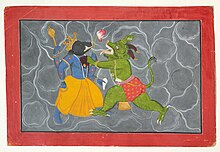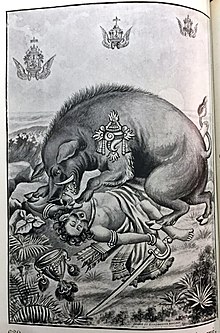Hiranyaksha
| Hiranyaksha | |
|---|---|
 Varahabattles the Hiranyaksha, Scene from theBhagavata PuranabyManaku of Guler(c. 1740) | |
| Affiliation | Asura |
| Abode | Patala |
| Weapon | Mace |
| Genealogy | |
| Parents | KashyapaandDiti |
| Siblings | Hiranyakashipu(elder brother) Holika(younger sister) |
| Consort | Rushabhanu[1] |
| Children | Andhaka |
Hiranyaksha(Sanskrit:हिरण्याक्ष,lit. 'golden-eyed',IAST:Hiraṇyākṣa), also known asHiranyanetra(Sanskrit:हिरण्यनेत्र)[2]was anasuraas perHindu mythology.He is described to have submerged the earth and terrorised thethree worlds.He was slain by theVaraha(wild boar) avatar ofVishnu,who rescued the earth goddessBhumiand restored order to the earth.[3][4]
Legend
[edit]
Some of thePuranaspresent Hiranyaksha as the son ofDitiandKashyapa.[5]Having performed austerities to propitiateBrahma,Hiranyaksha received the boon of invulnerability of meeting his death by neither any god, man, nor beast.[6][7]
Having received this boon, Hiranyaksha assaulted the defenceless Bhumi and pulled her deep beneath thecosmic ocean.The other deities appealed toVishnuto save the earth goddess and creation. Answering their plea, Vishnu assumed the avatar of a wild boar (Varaha) to rescue the goddess. Hiranyaksha attempted to obstruct him, after which he was slain by Vishnu.[5][8]
Hiranyaksha had an elder brother namedHiranyakashipu,who similarly achieved a boon of invulnerability and conquered the three worlds, seeking vengeance for his brother's death.[9]He tried to persecute and abuse his sonPrahladafor being a faithful devotee of Vishnu. While Hiranyaksha was slain byVaraha(the boar avatar of Vishnu), Hiranyakashipu was killed byNarasimha(the man-lion avatar of Vishnu).[5]Their younger sister wasHolika,who tried to kill her nephew by attempting to immolate him but got burnt herself and killed.
In some texts including theBhagavata Purana,Hiranyaksha is an incarnation of one of thedvarapalas(gatekeepers) of Vishnu namedVijaya.Vishnu's guardiansJaya-Vijaya,were cursed by theFour Kumaras(Brahma's sons) to incarnate on earth either three times as enemies of Vishnu, or seven times as his devotees. They chose to take birth on earth thrice. During their first births (during theSatya Yuga), they were born as Hiranyakashipu and Hiranyaksha. During their second births, (during theTreta Yuga), they were born asRavanaandKumbhakarna.During their third births (during theDvapara Yuga), they were born asShishupalaandDantavakra.
Origins and significance
[edit]
This Hindu legend has roots in theVedic literaturesuch asTaittariya SamhitaandShatapatha Brahmana,and is found in many post-Vedic texts.[10][11]These legends depict the earth goddess (Bhumi orPrithvi) in an existential crisis, where neither she nor the life she supports can survive. She is drowning and overwhelmed in the cosmic ocean. Vishnu emerges in the form of a man-boar avatar. He, as the protagonist of the legend, descends into the ocean and finds her. She hangs onto his tusk, and he lifts her out to safety. Good wins, the crisis ends, and Vishnu once again fulfills his cosmic duty. The Varaha legend has been one of many archetypal legends in the Hindu text embedded with the theme of right versus wrong, good versus evil symbolism, and of someone willing to go to the depths and do what is necessary to rescue the righteous and upholddharma.[10][11][12]
See also
[edit]References
[edit]- ^"Hiraṇyakaśipu consoles his mother and kinsmen [Chapter 2]".30 August 2022.
- ^George M. Williams (27 March 2008).Handbook of Hindu Mythology.Oxford University Press. pp. 54–.ISBN978-0-19-533261-2.Retrieved28 August2013.
- ^Williams, George M. (27 March 2008).Handbook of Hindu Mythology.OUP USA. p. 155.ISBN978-0-19-533261-2.
- ^Jones, Constance; Ryan, James D. (2006).Encyclopedia of Hinduism.Infobase Publishing. p. 189.ISBN978-0-8160-7564-5.
- ^abcRoshen Dalal (2010).Hinduism: An Alphabetical Guide.Penguin Books. p. 159.ISBN978-0-14-341421-6.
- ^Cole, W. Owen (1 June 1996).Six World Faiths.A&C Black. p. 29.ISBN978-1-4411-5928-1.
- ^Phillips, Charles; Kerrigan, Michael; Gould, David (15 December 2011).Ancient India's Myths and Beliefs.The Rosen Publishing Group, Inc. p. 59.ISBN978-1-4488-5990-0.
- ^George M. Williams (2008).Handbook of Hindu Mythology.Oxford University Press. pp. 154–155, 223–224.ISBN978-0-19-533261-2.
- ^Hudson, D. Dennis (25 September 2008).The Body of God: An Emperor's Palace for Krishna in Eighth-Century Kanchipuram.Oxford University Press. p. 202.ISBN978-0-19-045140-0.
- ^abH. von Stietencron (1986). Th. P. van Baaren; A Schimmel; et al. (eds.).Approaches to Iconology.Brill Academic. pp. 16–22 with footnotes.ISBN90-04-07772-3.
- ^abDebala Mitra,’Varāha Cave at Udayagiri – An Iconographic Study’,Journal of the Asiatic Society5 (1963): 99-103; J. C. Harle,Gupta Sculpture(Oxford, 1974): figures 8-17.
- ^Joanna Gottfried Williams (1982).The Art of Gupta India: Empire and Province.Princeton University Press. pp. 42–46.ISBN978-0-691-10126-2.
- Dictionary of Hindu Lore and Legend(ISBN0-500-51088-1) by Anna Dhallapiccola


